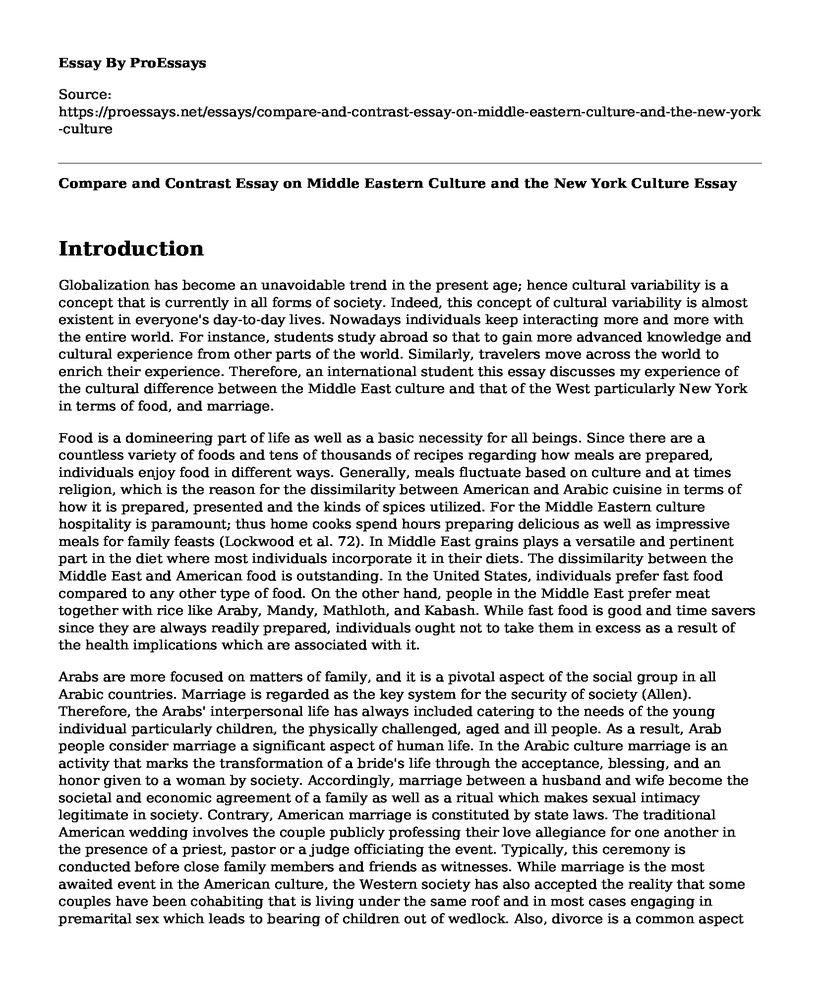Introduction
Globalization has become an unavoidable trend in the present age; hence cultural variability is a concept that is currently in all forms of society. Indeed, this concept of cultural variability is almost existent in everyone's day-to-day lives. Nowadays individuals keep interacting more and more with the entire world. For instance, students study abroad so that to gain more advanced knowledge and cultural experience from other parts of the world. Similarly, travelers move across the world to enrich their experience. Therefore, an international student this essay discusses my experience of the cultural difference between the Middle East culture and that of the West particularly New York in terms of food, and marriage.
Food is a domineering part of life as well as a basic necessity for all beings. Since there are a countless variety of foods and tens of thousands of recipes regarding how meals are prepared, individuals enjoy food in different ways. Generally, meals fluctuate based on culture and at times religion, which is the reason for the dissimilarity between American and Arabic cuisine in terms of how it is prepared, presented and the kinds of spices utilized. For the Middle Eastern culture hospitality is paramount; thus home cooks spend hours preparing delicious as well as impressive meals for family feasts (Lockwood et al. 72). In Middle East grains plays a versatile and pertinent part in the diet where most individuals incorporate it in their diets. The dissimilarity between the Middle East and American food is outstanding. In the United States, individuals prefer fast food compared to any other type of food. On the other hand, people in the Middle East prefer meat together with rice like Araby, Mandy, Mathloth, and Kabash. While fast food is good and time savers since they are always readily prepared, individuals ought not to take them in excess as a result of the health implications which are associated with it.
Arabs are more focused on matters of family, and it is a pivotal aspect of the social group in all Arabic countries. Marriage is regarded as the key system for the security of society (Allen). Therefore, the Arabs' interpersonal life has always included catering to the needs of the young individual particularly children, the physically challenged, aged and ill people. As a result, Arab people consider marriage a significant aspect of human life. In the Arabic culture marriage is an activity that marks the transformation of a bride's life through the acceptance, blessing, and an honor given to a woman by society. Accordingly, marriage between a husband and wife become the societal and economic agreement of a family as well as a ritual which makes sexual intimacy legitimate in society. Contrary, American marriage is constituted by state laws. The traditional American wedding involves the couple publicly professing their love allegiance for one another in the presence of a priest, pastor or a judge officiating the event. Typically, this ceremony is conducted before close family members and friends as witnesses. While marriage is the most awaited event in the American culture, the Western society has also accepted the reality that some couples have been cohabiting that is living under the same roof and in most cases engaging in premarital sex which leads to bearing of children out of wedlock. Also, divorce is a common aspect for married couples in the West due to their culture allowing for a convenient legitimate process.
Conclusion
In conclusion, culture is a significant part of an individual's lives as it influences their humor, values, hope, views and fears and worries. Indeed, understanding other people's culture plays a vital role in overcoming ethnic and racial differences. As a result, through my experience with the American marriage culture, I have learned to accept the idea that there is a need to recognize children born out of wedlock. Indeed, appreciating cultural diversity has helped to develop an equal society.
Works Cited
Allen, Douglas B. Culture and self: Philosophical and religious perspectives, East and West. London: Routledge, 2018.
Lockwood, W. G., Lockwood, Y. R., Abraham, N., & Shryock, A. (2015). Continuity and adaptation in Arab American foodways. Food and Folklore Reader, 72.
Cite this page
Compare and Contrast Essay on Middle Eastern Culture and the New York Culture. (2022, Dec 02). Retrieved from https://proessays.net/essays/compare-and-contrast-essay-on-middle-eastern-culture-and-the-new-york-culture
If you are the original author of this essay and no longer wish to have it published on the ProEssays website, please click below to request its removal:
- How Social Identity Theory Persuade Audience See Value in the Message
- Essay Sample on Creating a Self-Care Plan: Linking Social Justice and Wellbeing
- Culture: Impact on Communication & Interpersonal Skills - Essay Sample
- Essay Example on Conflict: Causes & Challenges in Interpersonal Relationships
- Essay Example on The Hybridity of Mary Jemison & Mary Rowlandson: A Cultural Uneasiness
- Essay Sample on My Dream of Visiting the Bible Land Museum in Israel
- Creation in Biblical Perspective Discussion Questions - Free Report







